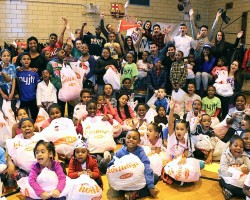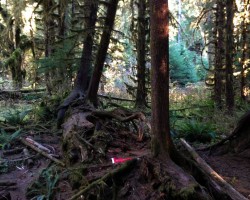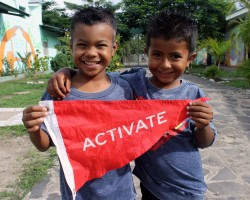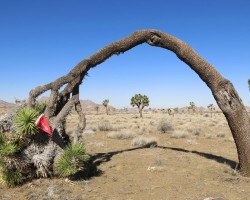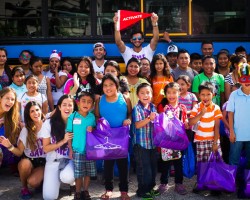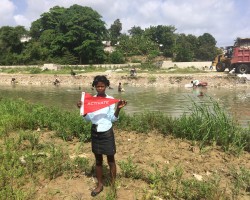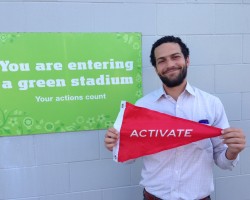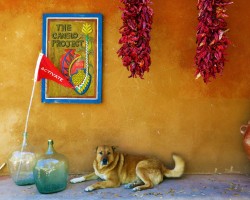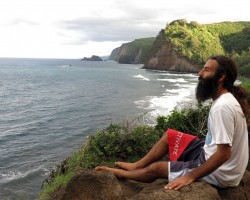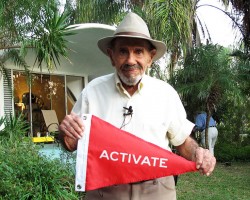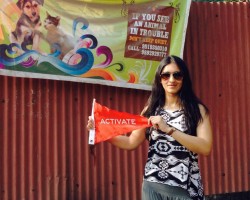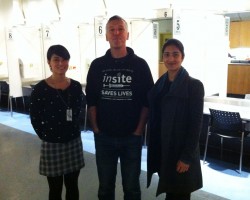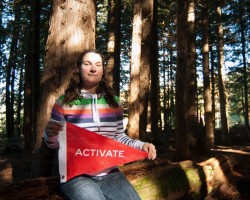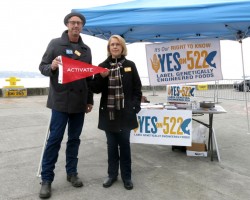Activate Project
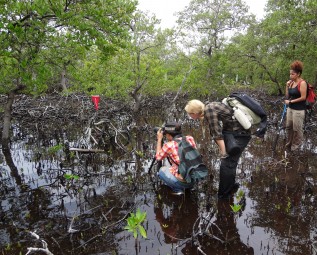
RAISE A RED FLAG
The Activate Project is open to anyone who would like to raise awareness about an issue important to them. The project started with 10 flags that are currently making their way around the globe: 1 in Brazil, 1 in Spain, 1 in Senegal, 1 in New Zealand, 1 in Florida, 1 in New York, 1 in China, 1 in the Philippines, 1 in Turkey and 1 in Portugal. As these flags pass hands from one concerned world citizen to the next, problems and solutions are being discussed. Awareness is being raised through the simple act of raising a flag. As the flags are being raised we will share them here with you. We also invite you to join. For more information on how you can get involved please email us at info@redflagmagazine.org
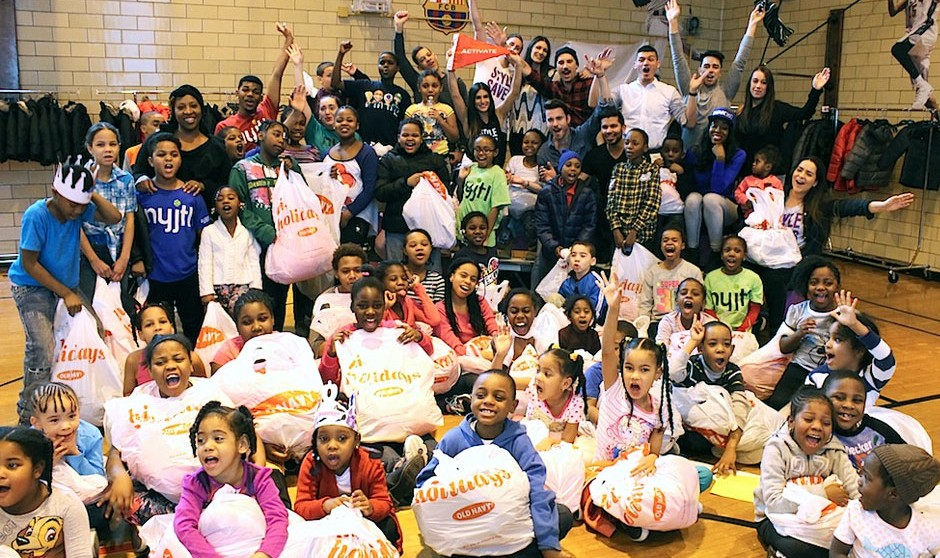
Flag # Brooklyn, New York
For our first installment of Coats for Kids, we partnered with IMG and William Morris Endeavor to outfit over 250 students from Brooklyn’s The Fresh Creek School with brand-new outerwear and winter coats. Taking place on Martin Luther King Day, Style Saves provided a fun-filled, fashion-focused event that promoted health, fitness and the spirit of giving back.
Youth Advocate and pro-athlete Tanyka Renee of Dunk360 co-hosted the interactive day and entertained students with squat races and freeze dance competitions, providing a fun spin on fitness. And when they weren’t working out, students were encouraged to tap into their inner creative genius and engage in arts and crafts projects. Perry Ellis and Nautica sponsored some of the winter gear and accessories provided to students, while industry pro and Style Saves President Rachael Russell gave individualized styling advice to each child. Together with the support of several members of the Style Saves family, each lucky attendee walked away with new duds to brave the coldest months of the season, a full belly courtesy of Nuchas empanadas and memories they’ll never forget.
Coats For Kids marks Style Saves’ first event in New York City made possible by the overwhelming support and fundraising efforts of our patrons. Recent events and activations including a luncheon hosted by Larsa Pippen at Fendi Chateau Residences in Miami Beach, an online auction on Charitybuzz.com and a in-store shopping experience at Vince in Bal Harbour Shops all contributed to the wildly successful outcome of this inaugural New York-based event.
Style Saves, now in its 4th year, is lead by FORD fashion stylist Rachael Russell and a team of fashionable philanthropists, in conjunction with The Miami Foundation. The organization raises funds through fashion and health events and is most recognized for its annual Style Saves Swim Fashion Show during Miami Swim Week. This year, the fashion show raised over $150,000, allowing Style Saves to host over 800 local students at the Adrienne Arsht Center for the Performing Arts of Miami-Dade County for its fourth annual back-to-school event. Students were gifted with brand new back-to-school uniforms, outfits and accessories. In three years Style Saves has styled and dressed over 5,000 students and now operates in Florida, Connecticut, Rhode Island and New York.
To learn more or get involved with Style Saves please visit www.stylesaves.org.

Flag #2 Olympic Peninsula, Washington
Location: Hoh Rain Forest, Olympic National Park, Olympic Peninsula, Washington, USA.
Off the coast of Washington, the Olympic Peninsula diverges from the mainland and slips into the Pacific Ocean – surrounding itself on three sides by the cold northern waters. On the western edge, shielded by the Olympic Mountains is a strip of temperate rain forest, the only of its kind in the continental U.S. As you wander through these woods you will meet Maple trees, Alders, Spruce and Cottonwood covered in blankets of moss and fern. Their shapes resemble tree gnomes and hobbits – the type of lure we only know through fairytales. There was a time when much of the land was covered in these forests and human life was established on its fringes. The medicines, food, resources, and refuge these forests offered was taken in small amounts and only as needed.
Today almost all of original forests in the U.S. have been logged or otherwise disturbed. Less than 1% are left in the east and 5% in the west. The majority of Americans will never get to see an old-growth forest. There is no national organization or government agency working to protect the remaining ancient forests nor to preserve recovering forests.
The forests on the Olympic Peninsula are protected as part of the Olympic National Park, but both nationally and globally, old growth forests and forest ecosystems are under threat. Through awareness campaigns the public has become somewhat familiar with the importance of standing up against deforestation, especially the global campaign to protect the world’s tropical rain forests.
The important piece for us to understand is that an old growth forest is very valuable. In fact, it’s irreplaceable. Like an elder, it carries knowledge from earlier eras. It has learned from years of life on this planet how to live on this planet. Imagine the internet 10 years ago. Now imagine it in 100 years. What the internet will be able to provide to humans in 100 years is unfathomable. It will likely reflect back to us billions of our expressions, desires, communications – our dreams, our stories, our facts and information plus a multitude of resources we can’t even imagine at this time. This is what an old growth forest holds beneath its shaded canopy. There is complex knowledge held by the vast network of mycelium under the soil that has been developing for centuries as each leaf, branch, bark and forest creature has made its way to the forest floor and returned to the soil – to the humus from which it came. The trees, shrubs, ferns, flowers, mushrooms, insects, mammals and other creatures have evolved together to a state of perfect balance after years of practice.
There is so much to be learned from old growth ecosystems. The conservation of these forests needs a collective voice and in time that voice needs to get louder.
A place to add your voice is among those who are part of The Old-Growth Forest Network, an organization created in 2007 by Joan Maloof, Professor Emeritus at Salisbury University in Maryland. The organization’s mission is to identify and help protect one forest in each county of the U.S. where forests could grow (approximately 2,370 counties out of 3,140) and let people know where they were located. “In this way, I believe, we could help stop the destruction of what old-growth remained, help some forests recover, and enable more Americans to experience an old forest.
>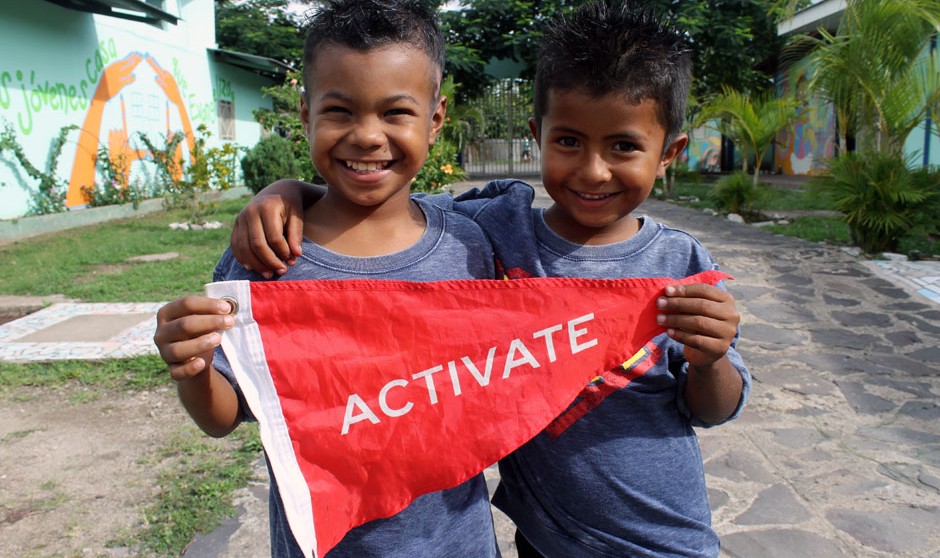
Flag #10: Nicaragua
Name: “Style Saves”
Location: Estelí, Nicaragua
by Regina Arriola Cauff
Style Saves is non-profit organization operating under The Miami Foundation that raises funds through fashion and art activations in order to provide brand-new clothing to underprivileged students. In just four years, the Style Saves cause has reached children in other countries including Peru and Indonesia, and most recently, Nicaragua. For seven days, myself and two members of the Style Saves team traveled to Estelí to work alongside the generous and struggling Saleisian sisters at El Centro Sor Maria Romero. Sor Anita, Sor Emilse and Sor Liliana are the devoted sisters that work day-to-day to maintain the progression and upkeep of their school and orphanage. Together, they provide free education to their students and a safe and loving living environment for them. On school days, their soup kitchen is open to any child for breakfast or lunch. The sisters offer social services including food donation to the hungry and loans for families in need. The livelihood of the Estelí community relies on the Saleisian sisters’ selfless work and attention.
Throughout our time in Estelí, we focused on creating a mentorship program and experience for both the orphaned children residing at El Centro Sor Maria Romero and local kids. Each day, we invited children to participate in arts and crafts, play dress-up and receive manicures, pedicures and haircuts. With generous donations,we provided students with brand-new clothes, shoes and accessories. We’ve funded the rebuilding of walls at El Centro, given jobs to those involved in constructing them, and even participated in it.
Keyding Torres lives across the street from El Centro. Nearly one year ago, her home burnt down from an electrical fire, leaving Keyding and her family with virtually nothing but gravel, dirt and unstable slabs of tree trunks for shelter. Keyding, her sister Jarixa and their parents Deisy and Ismael share a 14×16 living space that is endangering both their physical and mental wellbeing.
Style Saves patrons helped us raise a total of $4,000 for the Saleisian sisters at El Centro Sor Maria Romero. With these funds, we provided the materials for the rebuilding of Keyding’s home, gave over 50 children mini makeovers, and sent them home with hygiene kits filled with necessities like shampoo, soap, deodorant, hair combs, toothbrushes, toothpaste and underwear—basic items widely unavailable to these children.
We mentored the children we met in Esteli, listened to them and formed deep-rooted relationships with many of them. At the close of our week, we gifted the Saleisian sisters with over $1,000 in cash leftover from donations— providing them the means to continue their work. To put things into perspective, $20 feeds over 100 children with chicken for the day.
To learn more or offer your support to our next project visit http://stylesaves.org/
>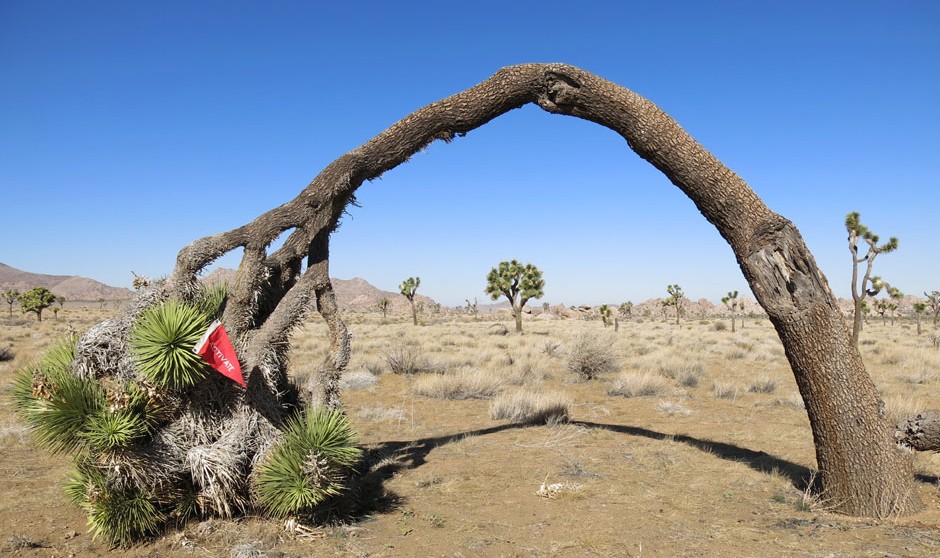
Flag #2: Joshua Tree, California
Location: Joshua Tree National Park, California
The Joshua Tree is a high desert plant, that dates back over two million years ago. Mormons gave the Joshua Tree its name in the early 19th century – because it reminded them of the biblical prophet Joshua with his arms upraised in prayer. They saw this plant as a spiritual sign of welcome into the Promised Land and used it as a guide to find their way from California to Utah.
The tree is believed to be a relic of a time that was more moist, but today has adapted to the arid desert climate. As part of its adaptation the Joshua Tree has a special relationship with the night. The leaves actually remain dormant during the day, and save their respiration cycle for the night-time hours when the air is cooler, and moisture can be conserved. It is also at night when the Pronuba moth pollinates the flowers. A number of observers have noted that the Joshua Tree flowers, which never appear fully open, reveal themselves more to the night, as well as releasing their fragrance into the night air. Joshua Tree is in its full glory in a moonlit desert night, as its white flowers glow in the eerie luminescence of reflected light.
In recent years, with the onset of more frequent and longer lasting droughts the tree has almost halted it’s reproduction cycle. At a study site in Wickenberg, Arizona, there have been no new Joshua Trees in over 30 years. Yet, each year in the spring they still produce their fragrant blooms. This past spring the Joshua Tree flowering was considered by locals and park keepers at Joshua Tree National Park in Southern California to be the showiest in recent memory. Scientists hypothesize that the severe drought suffered by California and other states in the western United States triggered the trees to produce more flowers and in effect more seeds as a desperate attempt to survive as a species.
This is just one story of one unique species of life on earth trying to survive the changes happening on our planet, be it climate change, habitat loss, scarcity of vital resources or facing competition instead of cooperation between humans and their own kind.
>
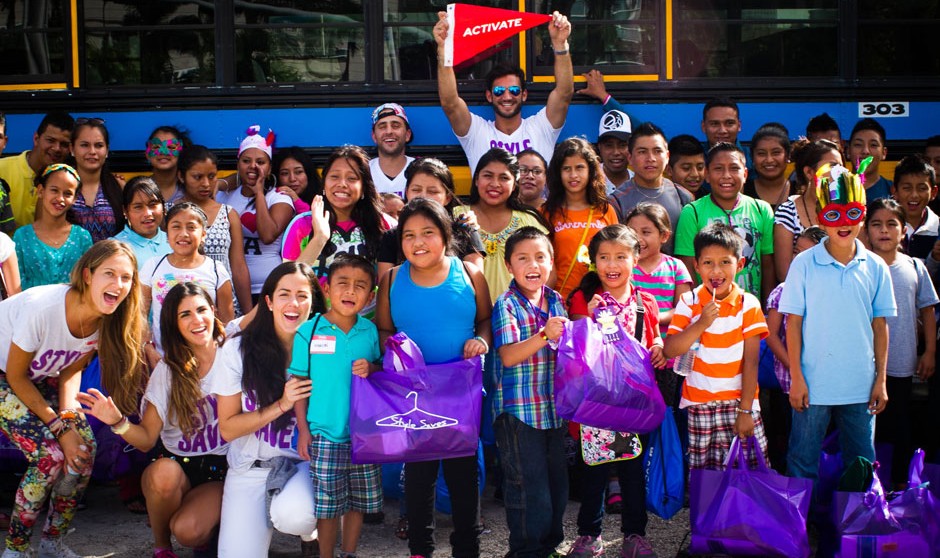
Flag #10: Florida
Name: “Style Saves”
Location: Miami, Florida
Text by Regina Arriola Cauff
Nearly 73% of children in Miami-Dade County live at or below the poverty line, with over 3,300 of those and their families currently homeless. Didn’t someone once say that you must be the change you wish to see in the world?
While on my honeymoon to Southeast Asia, my husband and I traveled to places like Chiang Rai, Thailand and Siem Reap, Cambodia, where I was exposed to a level of poverty that represented a world previously unknown to me. I knew that extreme destitution existed in the world, but coming face-to-face with the sad truth that most of the children I met would never know a different reality, seemed cruel. This firsthand understanding sparked an overwhelming eagerness in me to play an active role in the future of children without the opportunities of those who are more fortunate –And I didn’t have to look very far.
Upon returning to Miami, my hometown, I connected with Rachael Russell, a FORD fashion stylist and the Founder of Style Saves. At age 23, Russell started the organization after going back-to-school shopping with her younger siblings. It occurred to her that not every child is afforded the opportunity to begin the school year with stylish new clothes, and that just didn’t sit well with her. Soon after, Style Saves was born.
During our initial meeting, I knew that Rachael was someone I wanted to spend time with—she was equal parts driven, ambitious and knowledgeable about the non-profit world, and I wanted to learn everything she knew. Since then, and together with a well-rounded Board of Directors, we were successful at dressing over 700 students with brand-new, back-to-school outfits and uniforms.
The fourth annual Style Saves Back-to-School in Style initiative took place at the Adrienne Arsht Center for Performing Arts on August 16 and 17, and welcomed families from local organizations including Big Brothers Big Sisters, Lotus House, Mentor Network, Irie Foundation and The Guatemalan-Maya Center. Aside from shopping, the day included interactive activities like eye exams by Visionworks, manicures, pedicures, haircuts and yoga lessons for kids.
Style Saves has doubled its reach with each installment; a challenging feat accomplished through generous in-kind donations, fundraising efforts and the selfless dedication of each unpaid volunteer. In the spirit of the aforementioned words declared by Gandhi, the presence of change first comes from within.
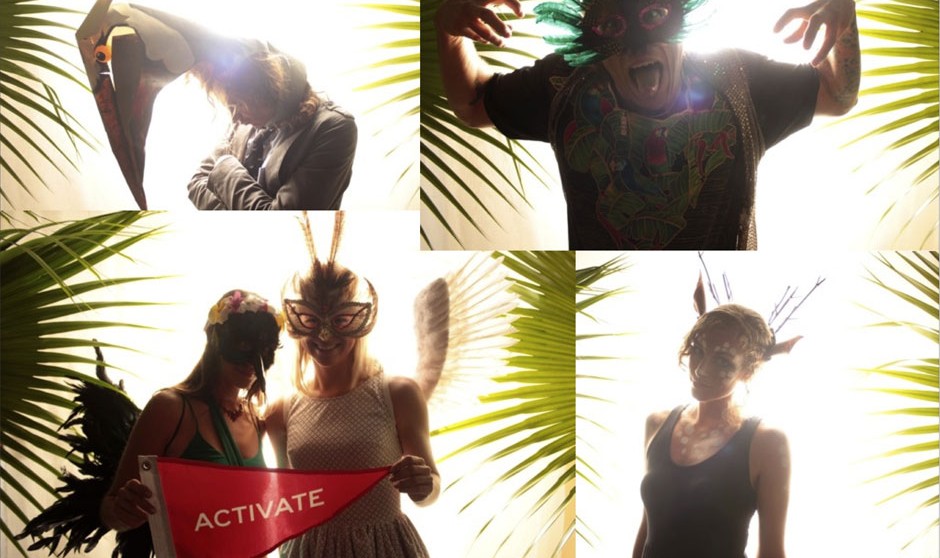
Flag #10: Miami, Florida
Location: Miami, Florida (Primary Projects Gallery)
Name: The Feast of Species
In May 2014, in celebration of the “Animal Issue”, Red Flag Magazine hosted a dinner party where each guest was required to arrive dressed as a creature of their choice. 50 guests in total sat at one long dinner table where they were invited to embody and represent that creature for the evening. A five course vegan dinner was served as each guest stayed in character to shed light on their creature’s special traits and on what each species needs to thrive in a world that is losing a piece of its natural habitat to human intervention every second.
A woman dressed as a snow leopard spoke her turn: ” I am a solitary creature. I live in high elevations, in cold craggy mountains. I am crepuscular, which means I am most active at dawn and dusk. I cannot roar. Instead, I hiss, and growl. When the wind blows hard I use my long fluffy tail as a blanket to shield my face. I am endangered and you will likely never see me in the wild even if you seek me out your entire lives.” The shark sitting next to her nods, he has his own burdens to bear. He may not be endangered, but not many seek him out. After media coverage the likes of “Jaws” and “Shark Week” most people are happy to never see a shark in their lifetime. For this reason people are also slower to stand up for their rights, and shark fining trade continues to decimate millions of sharks in our waters every year. Meanwhile, on average, only one human is killed from a shark attack off American shores every two years.
Many species are endangered and some of the dinner guests represented those who have already passed into extinction. Animals in their wild native habitat are becoming rarer and rarer, and it was clear from the joy on the faces of all the hooved, clawed, winged, and furry guests that it’s also becoming rare for humans to be the wild creatures that we are. “Wild” is more a concept than it is a real flesh and blood thing in the world. We have sectioned off patches of land and designated them as “wilderness”, but then we build roads, parks grounds, surveillance, dams and drills within those lines. The wild places are nearly gone and all the wild things must conform to the ways of the altered world we’ve created.
One guest, a very wise owl, addressed the table: “I believe those humans have many habits and what they call “rituals”. For example, sometimes before they eat they light candles and say blessings. I don’t know what that means, but I was hoping we could try it.” And so, in the soft candle light 50 creatures held hands and shared the ritual of a blessing.
>
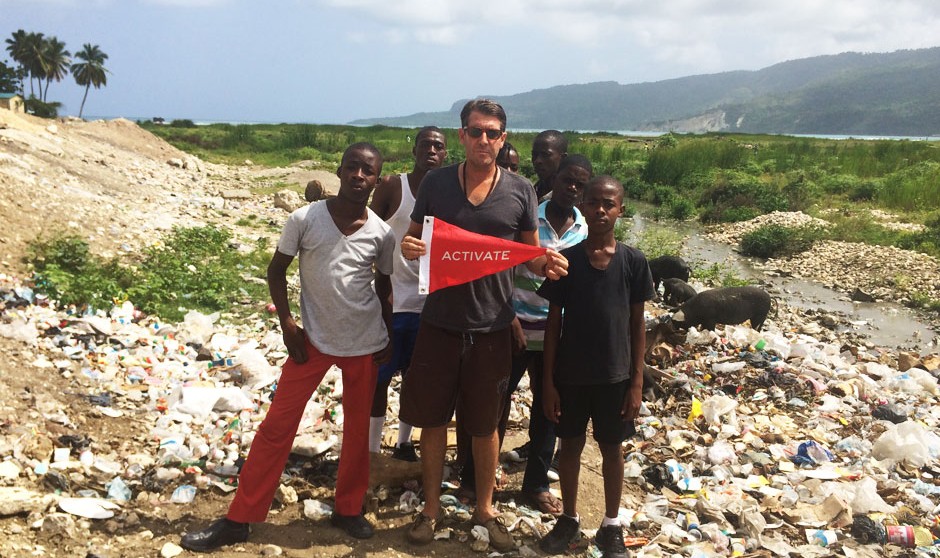
Flag #10: Haiti
Location: Jacmel, Haiti
Text and photos by Michael Capponi
I arrived in Haiti the first time on day 5 of the January 12, 2010 earthquake with a team of Miami Beach Firefighters, nurses and doctors. Nothing in life had prepared me for what I saw in those days to come. It was a short mission and when we returned I felt propelled to immediately return with more aid.
Two weeks later I came back with tents and more supplies. This is a picture of a little girl named Darline Dimanche and her brother Michaelson camped out in the mud. I immediately set them up into a temporary tent and gave them what I could; food, clothing , sheets etc.
During the first year I saw and clearly understood the root at the problems facing Haiti. As my heart and soul only wanted to help them all, I took on some serious responsibilities such as committing to giving a new shot at life to over 60 other beautiful children like Darlene along with their parents.
In December 2011 we transported 60 children and adults that were living in our temporary camp to the south east coastal city of Jacmel. Our new mission was to uplift these children to their greatest potential. We set up basic infrastructure with a focus on education. Most children had never gone to school. Today they are all in private school learning to use computers and learning English. Throughout my 75 mission trips to Haiti we have grown an unbreakable bond to one another.
The first photo is of me with our 100 Haiti Empowerment Mission students and parents holding the Red Flag to Activate awareness that there are many successful missions in Haiti and Haiti is not to be forgotten.
In the second photo Darlene is holding the Red Flag in Jacmel’s river mouth where children bathe and a town of 60,000 also dump their trash here. It’s a perfect storm for water born diseases etc. Unfortunately, once rainy season starts the river will get wider and all this trash will float into the rivers they bathe in.
For more information visit: Haitiempowermentmission.org
>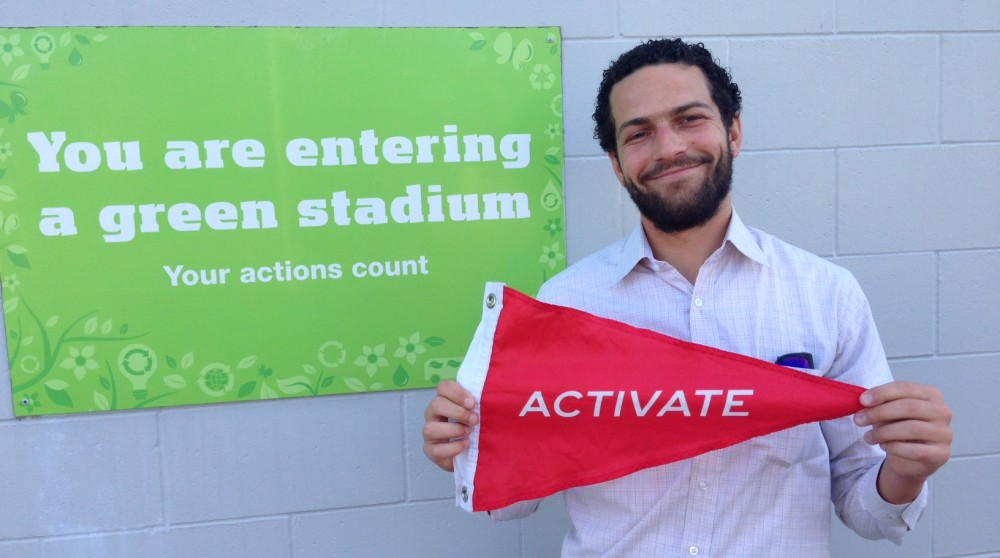
Flag #12: New Zealand
Location: Waikato Stadium, Hamilton, New Zealand
Name: Ben Lenzner
In March, April and May of 2014, the New Zealand Environmental Protection Authority (EPA) held a number of public hearings throughout the North Island. Trans-Tasman Resources Ltd. (TTR), an Australian mining company, plans to commence the largest seabed mining operation in the world off the west coast of the North Island of New Zealand. The hearings are the last chance the public has to chare their concerns about the proposed project. Sand on the west coast of the North Island is black and the seabed of the South Taranaki Bight is rich in iron ore. Where TTR intends to mine, they will strip the top layer of the seabed and separate the iron ore from the sand. TTR acknowledges that their operation will devastate the area of the seabed in which they will be mining. Blue Whales, Southern Right Whales, Maui and Hector Dolphins all migrate and reproduce through this region. Plume from the mining operation, the 24/7 sounds from the drilling machines and a number of other potential domino effects from this experimental operation may adversely impact these marine mammals and other types of marine life throughout the region.
In early April, I presented non-expert evidence to an EPA panel that will decide on whether TTR will be allowed to commence their mining operation. The hearings where inspirational and many residents of Raglan, the small town where I live, showed up to submit their thoughts about the proposed operation. Sometime in May of 2014, the TTR application will either be approved or rejected – the largest, most experimental seabed-mining endeavor ever to commence on this here globe. Below is an excerpt of the evidence I presented that early April morning:
“In a recent article on ocean based mining in the March 28 edition of The Guardian Weekly, Sylvia Earle, an oceanographer and explorer-in-residence for National Geographic states, “It’s like a land grab. It’s a handful of individuals who are giving away or letting disproportionate special interests have access to large parts of the planet that just happen to be under water.” She continues, “What are we sacrificing by looking at the deep sea with dollar signs on the few tangible materials that we know are there? We haven’t begun to truly explore the ocean before we have started aiming to exploit it.” And in a March 2014 video report on BBC World News online, Nii A. Odunton, the Secretary General of the Kingston, Jamaica based United Nations governed International Seabed Authority stated in regards to seabed mining exploration, “Those interested and who can put together the resources, the finances and technology to go recover them (i.e. ocean based rare earths) will be able to get as much of it as they want.” This statement, by an individual in power and given the authority of global oversight into the present and future of seabed mining and other forms of seabed extraction within international waters further reinforces one of my central fears about the core question of today’s hearing, “Should New Zealand, at this moment in time, allow seabed mining to occur off its West Coast?
How do we know what the negative impacts of seabed mining might be if we can’t see it or hear it or feel it or smell it or taste it or even begin to understand it? Trans Tasman Resources has acknowledged that the immediate areas of the seafloor where sand extraction takes place will destroy that area of seabed. Furthermore, they also concede that seabed mining has never taken place before on a scale they are requesting and never in a marine environment as we have off the west coast. They certainly don’t know what the future environmental impact of this mining will be. Neither do we. In fact, no one really does. Perhaps most disconcerting in my mind and most probably for the marine life that lives and migrates through these underwater regions will be the constant plume that is bound to have multiple effects on the amount of oxygen in the water, as well as affects on the multi-layered food pyramid of that area of the Tasman Sea.
Mining and the extraction of precious metals, oils, rocks, minerals and rare earths have overwhelmingly had negative effects on the environment. The environmental damage has been astronomical throughout the globe. The Tar Sands of Alberta, Canada have been shown to have future detrimental impacts on global warming. The Marcellus Shale in eastern North America, where a boom in fracking, a natural gas extraction method, has impacted natural water supplies across the state of Pennsylvania has also brought profound negative impacts that were never predicted. If one uses Google Earth to see the scars of these industrial methods of oil and gas extraction, it’s very evident, very clear, their impact on the surrounding natural environment. What is scary about seabed mining is on that very minimal level, a quick Internet search with our naked eye, a bird’s eye view, we won’t be able to see nor critique the impact of seabed mining. If one goes onto the New Zealand registered Internet homepage of Trans Tasman Resources, the tab one must click for further information on their proposed Seabed Mining is titled, “Iron Sands.” This is disturbing and can only make me think of the devastation wrought by the Tar Sands of Alberta, Canada. Tar Sands. Iron Sands. There seems to be a parallel.
The Merriam Webster dictionary defines an experiment as “a scientific test in which you perform a series of actions and carefully observe their effects in order to learn about something; or, something that is done as a test; or, something you do to see how well or how badly it works.” What sort of experiment might this Pandora’s Box open up off our coasts? José Marîa Figueres, former president of Costa Rica and co-chair of the Global Ocean Commission once suggested that the high seas be a no-go area for commercial exploitation (apart from shipping). Figueres was recently quoted in The Guardian Weekly of March 28,
Do we know enough about the seabed to go ahead and mine it? Do we understand enough about the interconnection between the seabed, the column of water, the 50% of the oxygen that the ocean produces for the world, the 25% of the carbon that it fixes in order to go in and disrupt the seabed in ways that we would if we went in and started mining? I don’t think so, not until we have scientific backing to determine whether this is something good or bad for the planet.
Why take advantage of an area of the world that is so critical to our well-being only for private profits? The economic gains are still unclear and if anything, what the New Zealand government will receive will be petty in comparison to the returns that Trans Tasman Resources will be reaping. As a student in this country, I say let us re-think this “deal” more clearly and methodically.
I stand here unwilling to put my support behind an extraction technique that undoubtedly has the potential for numerous and long lasting negative impacts on our environment and future generations of New Zealanders and the 195 or so other countries on this planet that we call our neighbors. An April 17, 2013 TV 3 report on seabed mining titled, Stripping the seabed: Bonanza or disaster? made clear that much of this iron ore will make its way to China and specified that this ore, New Zealand’s ore, it’s earth, will likely be used in China’s defense industries. I ask you, do we want iron ore off the coasts of New Zealand to be contributing towards the further militarization of this planet? Because should we agree to allow seabed mining take place in New Zealand, these global inter-connections will be difficult to refute.
We as global citizens are at a crossroads. Do we as a society give the green light for companies to pursue the extraction of rare earths at environmental costs to the planet that we have yet to ascertain? Do we, one day as grandparents, want to tell our grandchildren that we supported seabed mining or that we decided to take the high road, the moral and ethical path forward and that we decided to take a stand in 2014, that in fact our seabed is not for sale, that money and industry and economics is not what our pivotal values are centered around.”
For more information on the issues surrounding seabed mining off the west coast of New Zealand, check out the homepage of Kiwis Against Seabed Mining (KASM)
For further information on the EPA hearings
More Resources:
http://www.bbc.com/news/business-26611073
>
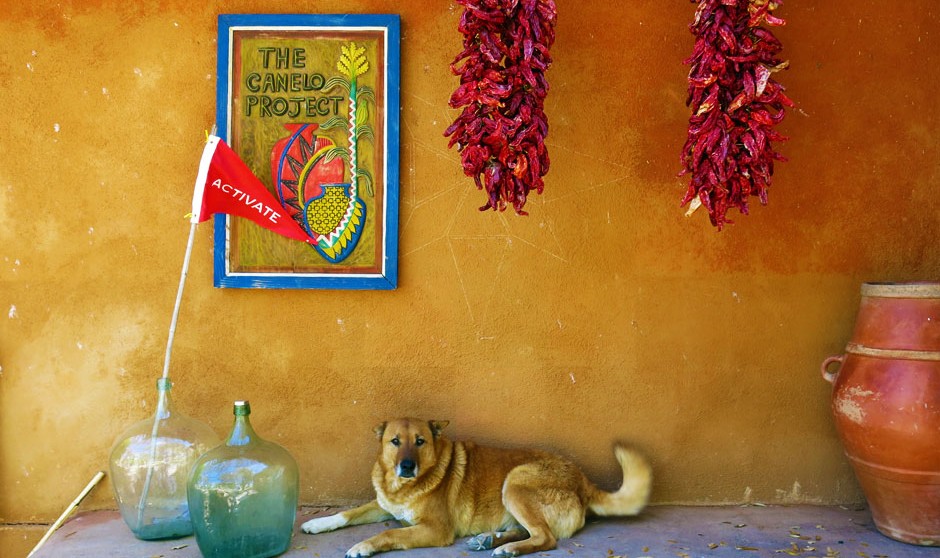
Flag #2: Arizona
Location: Canelo, Arizona
Names: Bill and Athena Steen
The Canelo Project is a small non-profit organization Bill and Athena Steen founded in 1989 and whose work centers on the theme – Connecting People, Culture and Nature.
The tiny town of Canelo, in southeastern Arizona, is home to The Canelo Project and the center of many of our activities . They rebuilt the old adobe ranch house and complex of buildings to function as a place where people of different backgrounds and cultures could come together to share in an ongoing exploration of living, building, the arts, music and regional foods.
The Steen’s have developed it as a center for learning, research, demonstration and cross-cultural gatherings. Their ongoing annual activities revolve around workshops, tours, intern programs and writing. The focal point of their work is handcrafting simple, small-scale and comfortable shelter that is built primarily with local and natural materials. In that pursuit, we have evolved a unique straw bale and clay wall system that is finished with beautiful clay and lime plasters – instead of paint – sculptural wall carvings, earthen floors and clay ovens.
The Canelo Project has inspired many to get their hands in the earth and to use that same earth upon which we stand to create the dwellings in which we live and gather. Learning to build your own dwelling from natural materials and designing the interior with the vision of your own creativity brings humanity and what makes each of us unique back into the places we live. In a world developing so rapidly and unsustainably these building practices and the sanctuary of the Canelo Project provide a place of respite for the global citizen looking for a new way to build our future world.
>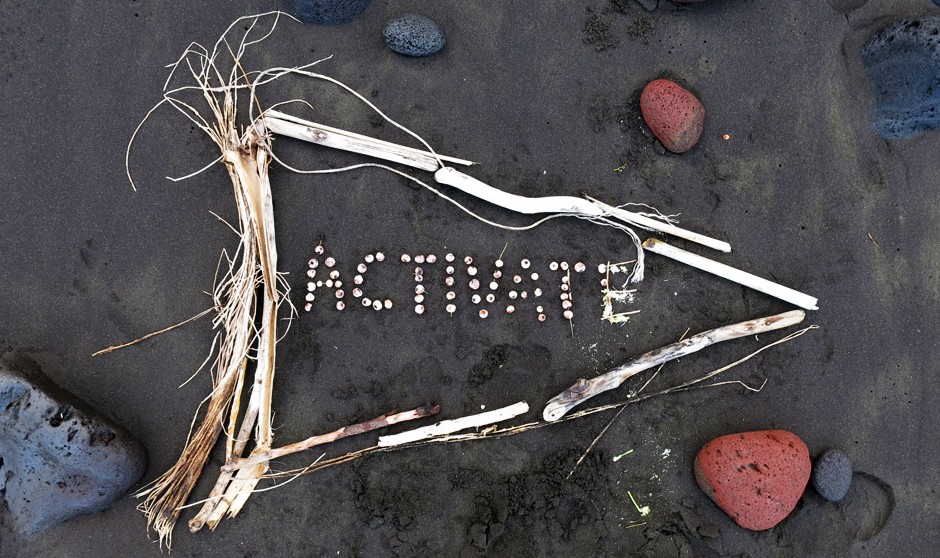
Flag #2: Big Island, Hawaii
Flag #2: Big Island, Hawaii
Location: Pololu Valley, Big Island, Hawaii
Name: Ganesha
The Pololu Valley is the first of a chain of seven valleys on the island of Hawaii. To the Hawaiian people, these valleys are sacred. Waipio Valley, the valley at the center of the seven valleys, is known as the Valley of Kings. It is said that Waipio was the home to the Hawaiian kings that ruled the islands.
At the northern ridge of Pololu Valley you can see all the seven valleys opening to the Pacific Ocean. At the valley’s floor there is a river cutting through a lush tropical forest that spills out to a black sand beach. The dark sand is a reminder that this island is still in creation. There are five volcanoes on the island and three are still active. Since 1980 over 600 acres have been added to the island from ongoing lava flows. In this sense the island is a young island and its spirit is one of change and renewal.
>
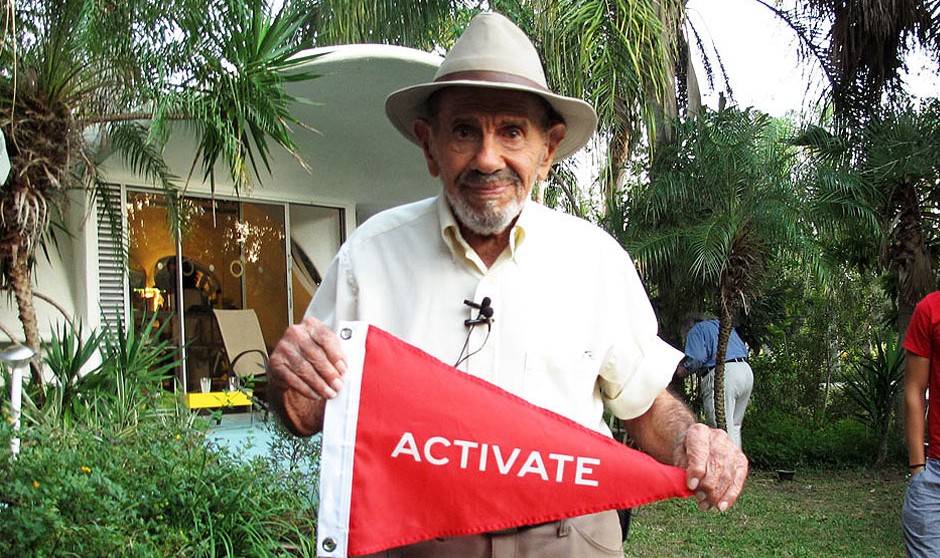
Flag #2: Venus, Florida
Location: The Venus Project in Venus, Florida
Name: Jacque Fresco
The Venus Project describes itself as “an organization that proposes a feasible plan of action for social change, one that works towards a peaceful and sustainable global civilization. It outlines an alternative to strive toward where human rights are no longer paper proclamations but a way of life.”
Jacque Fresco, its founder, was born in 1916 and at age 98 he still leads tours around Venus Project’s 21.5 acre research center with enthusiasm, indefagitable energy and infectious optimism for the future of human civilization. He is a futurist and self-proclaimed “social engineer” with a grand vision and design for an optimal human civilization that “celebrates the vast potential of the human spirit.”
On the property of the Venus Project, Jacque outpaced us along live oak and saw palmetto trails, past glittering ponds with Florida alligators sunning on their banks, to the futuristic structures he designed and built which are used to display live models and digital designs of a civilization that operates on a resource-based economy rather than on money, where food supply is no longer an issue and where civilizations can live on both land and sea without leaving a negative impact on ecosystems.
The charismatic Fresco has spoken at conferences around the world and has authored and produced a series of books and documentaries detailing the features and methods for engineering his vision. His book “The Best That Money Can’t Buy” goes into detail about the advantages of a resource based economy.
The Venus Project is named so after the town its research headquarters is located, not after the planet of Venus, although the name fits quite well with with Fresco’s forward thinking principles.
For more information on Jacque Fresco and the Venus Project visit:
>
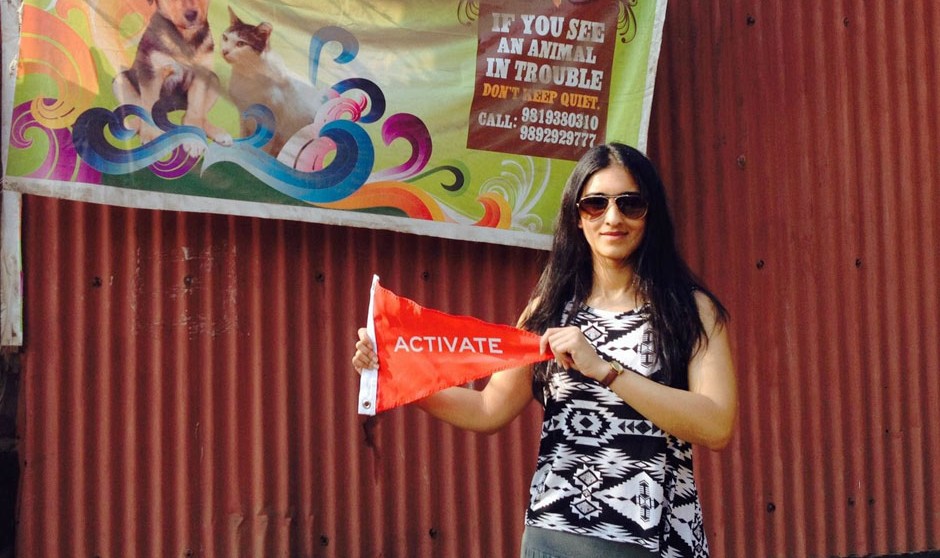
Flag #13: Mumbai, India
Location: Mumbai, India
Name: Raseel Sehmi
“If you see an animal in trouble don’t keep quiet” – this is the motto of a small non-profit called Animals Matter to Me. I ended up visiting this non-profit, tucked away in the suburbs of Mumbai in December 2013. Every year my family donates to a different cause and this year we decided to support stray dogs – a pervasive part of the city. There are two sides of the issue. On one side there are people who want to get rid of these ‘nuisances’ (imagine men and women biking to work in the early hours who are continuously chased and attacked by seemingly rabid dogs). And on the other side there are animal activists who want to save these dogs from being tortured and dying. AMTM is one of a few non-profits focusing on rescuing dogs (and other animals) and providing services like vaccinations, with the intention to make the streets of Mumbai ‘safer’.
This was the issue I wanted to ‘activate’ initially. But a story told to me by the cofounder of AMTM resonated even more – it’s the common story of extortion. Most non-profit workers often have thankless jobs, and any publicity of their work and the cause they serve is welcome. However, in this case (and many more I’m sure), publicity from a famous Indian actor ended up threatening the lives of these cofounders. Upon news of the actor’s support and assuming a hefty donation was made, several political gangs (or parties) harassed the non-profit for money. It took several months before the harassment stopped, and thankfully no one was injured in the process. This is shocking yet unsurprising given the prevalence of corruption in the country. It saddens me that such selfish acts hinder the positive societal change that can be made, and it certainly does not make the streets of Mumbai safer. Extortion is a much more dangerous encounter than stray dogs, I’d say. Yet it is encouraging to see that social workers still persevere despite such roadblocks.
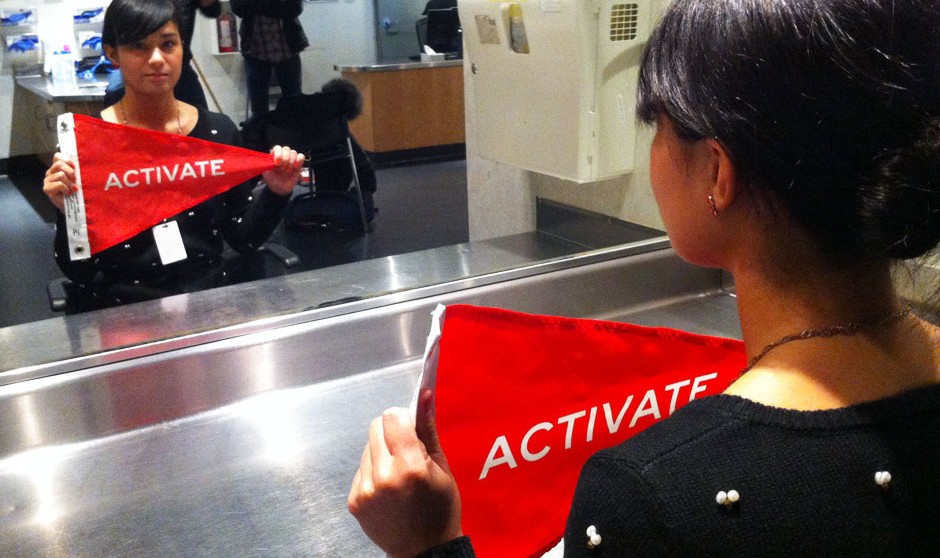
Flag #13: Vancouver, British Columbia
Location: Vancouver, British Columbia
Name: Aki Kaltenbach
Insite is North America’s first and only legal supervised injection site and sits in the heart of Vancouver’s Downtown East Side, an area notorious for a high incidence of poverty and drug use. Insite is a clean, brightly lit facility with a row of mirrored booths where users can inject drugs under medical supervision.
Aki lives in an apartment in one of the many new developments in the area and is part of the increasing gentrification of one of Canada’s poorest neighborhoods. Although controversial, this gentrification has lead to an incredibly diverse community with hipsters selling $3 gourmet doughnuts next to pawn shops and high end restaurants opening up across from Pigeon Park.
September 2013 marked Insite’s 10 year anniversary. With more than 2 million visitors to date with up to 800 visitors per day, Insite is a part of the fabric of the community and continues to receive public support in Vancouver and across the country despite numerous attempts to stop it – most recently by the federal government – from operating.
>
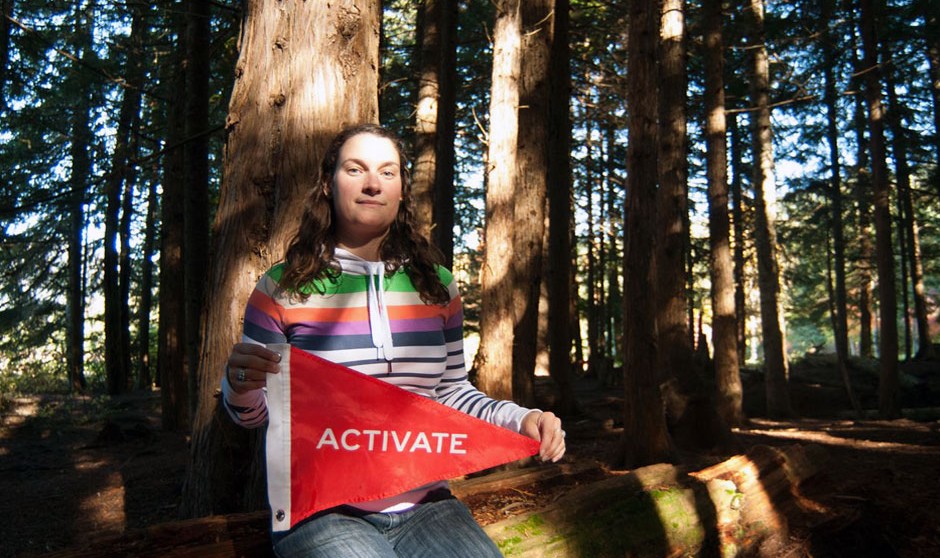
Flag #2: Whistler, British Columbia
Location: Whistler, BC, Canada
Name: Melanie Tardif
It was a day of celebration for Melanie Tardif when we met up with her in the Whistler woods. It was a beautiful Autumn Sunday and she had just been elected Vice President of the board of AWARE (Association of Whistler Area Residents for the Environment) – a group whose work is focused on protecting “the fast vanishing wilderness in our backyard.”
British Columbia is a wealth of wilderness with its own share of issues from logging, to mining, to the pipeline controversy and the constant need to keep a balance between the interests of the people and the interests of industry. Among its citizens are the indigenous members of the First Nations who also bring their own set of standards to how to interact with the land and its waters. It is often easy to agree that the environment needs to be preserved and cared for, but how and where those lines are drawn is where the challenges and conflicts arise.
One of the most controversial issues in the area is bear hunting. British Columbia issues permits by lottery each year to hunt both black and Grizzly bears. The numbers allotted are low, especially for Grizzlies, but to many residents, like Melanie, who has a background in Applied Ecology, it is apparent that the bears should not be hunted at all. Melanie explains, “Bears are a keystone species – an “Indicator Species” – their role in the health of the ecology is so critical.”
Luckily, it’s often common sense that compels people to take action. AWARE was founded in 1989 when residents gathered to push for a municipal recycling mandate at a time when recycling programs were not mainstream, but just made sense. Today AWARE is 300 volunteers strong and is one of the longest running environmental organization in Whistler. Their main focus outside of environmental advocacy is their educational programs and with their “Kids Nature Club” AWARE makes sure the young residents of Whistler learn about environmental protection and appreciation early on.
Melanie has served for the past 5 years as a volunteer for AWARE and for the past 2 of those years as a member of their board before being named Vice President. With a new title comes new responsibilities for Melanie. AWARE’s biggest focus right now is on the restoration of the wetlands in the region. The wetlands are like the lungs, the filter and a hub of life in an otherwise forest and mountainous terrain. It’s a rare jewel created by the yearly amounts of heavy precipitation, and it is also one of the most vulnerable habitats in the area. It can take years before municipal policy steps in, but Melanie has learned that patience is a virtue. One project that they started in 2007 to rid the town of Whistler of plastic bags is just now seeing some success after support from more citizen groups in the area and Whistler’s mayor Nancy Wilhelm-Morden, the the town will finally commence a 6-month trial to lower their use of plastic bags before even considering a full ban.
While policy might take longer – education is always accessible right now. AWARE has discovered that one of the most successful ways to initiate education is through enjoyment. Melanie teaches people how to enjoy the land through nature tours and in the winter she teaches snowboarding with the belief that the things that bring us the most joy are what we are most likely to protect.
To learn more about AWARE or to support their cause visit: http://awarewhistler.org/
For more about bear advocacy in the region visit: http://bearaware.bc.ca/
>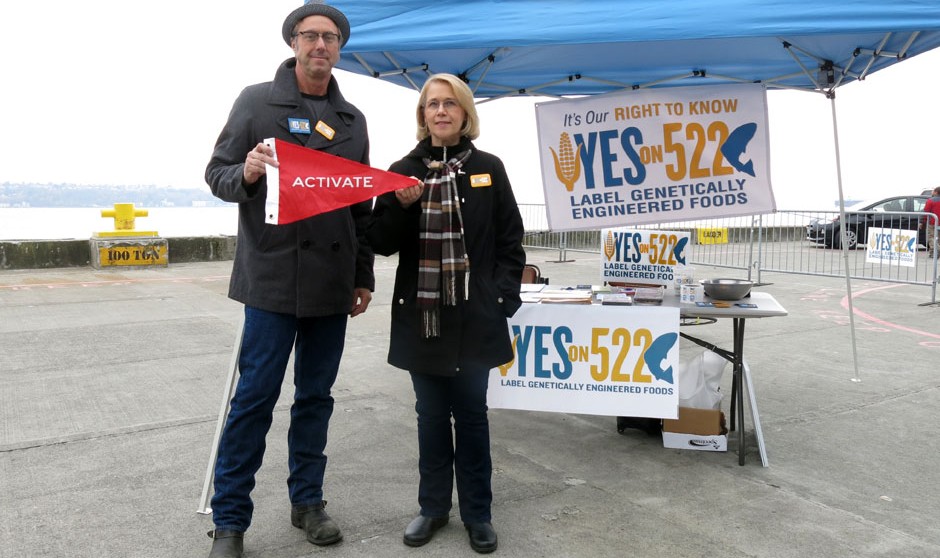
Flag #2: Seattle, Washington
Location: Seattle, Washington
Names: David McConnell and Cindy Black from “Volunteers for I-522”
With only days left until election day, citizens of Washington state are facing the opportunity to make their state a trailblazer in the stand against GMOs. So far only 2 US states, Connecticut and Maine, have passed legislation requiring labeling of GE/GMO foods, but their labeling won’t take effect until other states pass similar laws. If passed Initiative 522 would take effect in 2015 with or without the company of other states, but Washington state’s leadership could help effect similar legislation across the country.
There is much debate and controversy over GMOs. We published an article in our Food Issue detailing some of the concerns: Click here to read more.
One of the main concerns and myths preventing voters from supporting Initiative 522 is that labeling will increase costs for consumers and farmers alike. In truth the farmers and distributors are required to label their foods. They will be given a year to change their labels and no additional cost will land on the consumer.
There are many health concerns surrounding GMOs which is the main reason these labeling laws are beginning to appear on ballots. The issue has already been taken up by Europe. The US is behind on the matter and will hopefully become educated, use their voting power and take their own initiative to improve the quality of our foods.
“Volunteers for I-522” is a grassroots action group in Seattle composed of volunteers working to pass I-522, the 2013 Washington ballot initiative that will require the labeling of genetically engineered (GE) foods. They develop and execute political action focused on raising awareness and engaging voters, such as hosting rallies/marches, speaking tours, bannering, tabling (education), writing Letters to the Editor, and working with the I-522 campaign and other groups both local and national.
To learn more about this group visit: http://volunteersfori522.org/
>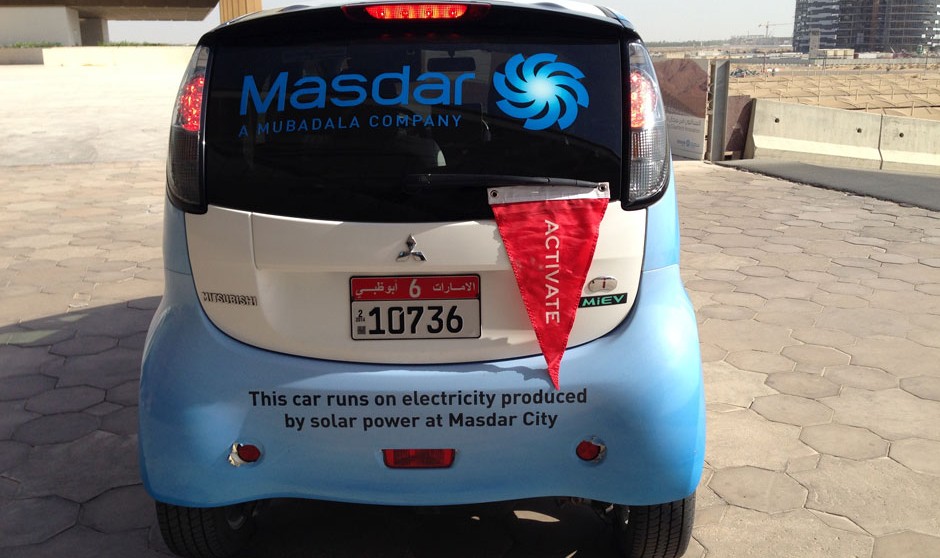
Flag #3: United Arab Emirates
Location: Masdar City, Abhu Dhabi, United Arab Emirates
In the middle of the desert, 11 miles outside of the city of Abu Dhabi, in the United Arab Emirates, a city of the future is being built. With funding coming directly from Abu Dhabi – one of the wealthiest cities in the world – and a design team hand picked from some of the best in the world – this city is being designed to be a leader in the race to living more sustainably on a planet whose capacity we have already pushed too far.
The city is called “Masdar”, which means “Source” in Arabic. The design team is comprised of firms and institutions from all over the globe – representing an international collaboration. The British architectural firm Foster and Partners are responsible for much of the design. The engineering is being managed by the Masdar Institute of Science and Technology with the aid of consultancy group Mott MacDonald and the Massachusetts Institute of Science and Technology (MIT). The city is being designed to rely entirely on solar energy and renewable sources with a zero waste ecology. Solar, wind, geothermal and hydrogen energy will be used to generate the power needed to run the city. Individual cars will be banned and transport will be supplied through solar powered communal transport systems. A solar powered desalination plant will be used to provide the city’s water needs. All plastics and non-organic waste will be recycled and re-purposed. 80% of the waste water will be reused as grey water. The wood used in some of the building projects is palmwood – considered one of the most sustainable wood sources available.
Construction on Masdar city began in 2008. The projected completion date was slated for 2016, but since construction began the same year as the global financial crisis there was an impact on construction plans and the projected completion date is now between 2020 and 2025 – And, while the initial plan was to create a zero-carbon city the city is now aiming to be low carbon.
